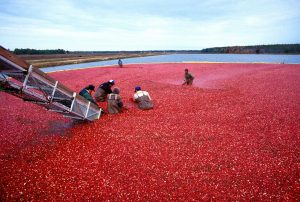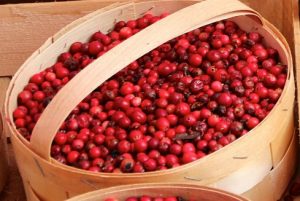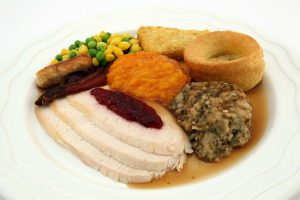Think cranberries!

From there, it’s not a long stretch to thoughts of Thanksgiving. And for a writer, creative juices might quickly stir up a Thanksgiving scene. Preparation of the feast provides a pantry full of opportunities to introduce characters and reveal personalities. Perhaps it creates tension, exposes secrets, or puts on an explosive display of the family dynamics.
Picture it: The hero says something−maybe innocently, maybe not.
The heroine’s blood boils akin to the cranberries and sugar bubbling furiously in the pot.
Or not.
If this piece is contemporary, the character can confidently cook up a pot of homemade cranberry sauce. It might be the traditional recipe of cranberries, water and sugar, or a zesty rendition with spices such as cinnamon, cardamom, or ginger.
But what if this piece is historical?
Was cranberry sauce readily available in the time period?
Consider the following:
The First Feast. Cranberries were native to northeast North America, thus they were likely not familiar to the settlers who had recently immigrated from Europe. Historians opine that the newcomers’ sugar supply had been depleted and they had no bread. Rising out of that and the influence of the local Indians, it has been suggested that raw cranberries and nuts might have been used to stuff the local fowl for that infamous meal.
Sweet and Saucy.
We may never know who concocted the first batch of cranberry sauce, or when. However, both German and Scandinavian immigrants are believed to have brought across the ocean the concept of cooking fruit. Further, John Josselyn, an English traveler (c. 1671), writes of boiling cranberries in water with sugar.
By the mid to late-nineteenth century, published cookbooks, which included recipes for cranberry sauce, appeared. The recipes reflected not only what has become traditional cranberry sauce (berries, water and sugar), but also the variations devised by pioneer cooks, such as sugar substitutes (honey, brown sugar, syrup, or molasses) and methods of preparation (mashing and straining, length of time to cook, and when to add sugar).
Availability of Cranberries. Early settlers in the New England region might have picked cranberries for their Thanksgiving table. However, folks living in other areas of America were likely dependent upon buying those celebratory berries in the marketplace…if the proprietors could acquire them.
The appearance of cranberry bogs in 1816 brought about an increase in the commercial distribution of cranberries. Nevertheless, markets would have remained limited to their seasonal nature (September to November), and to available modes of transportation from bog to market.

For example: Does the 19th century mid-west Mom and Pop general store boast a basket full of cranberries? Does the farmer’s wife have money to purchase a pound?
Canned Cranberry Sauce. In 1912, Marcus L. Urann explored canning cranberries. Success would expand the fruit’s availability from just the seasonal months to year round. By 1930, he joined with competing cranberry growers to form a cooperative which ultimately became Ocean Spray. Canned cranberry sauce arrived on market shelves in time for America’s 1941 Thanksgiving feast.
What can a writer glean from these tidbits to enhance a Thanksgiving scene?
For a basic historical setting, it may be enough to know that after 1890 the cook might open a cookbook or pull out a family recipe. After 1941, canned cranberry sauce might be the pick for the table.
However, if a main character is an aspiring and imaginative cook, or the plot is set in a cranberry growing community, getting bogged down in research on cranberry sauce might be a berry good experience.

Happy Feasting!

Jeannine Brummett lives in South Carolina with her husband of nineteen years, Don, who shares his three adult sons and three grandchildren with her. Reading is big on her list of things to do, but she also thrives on TV crime dramas, NBA basketball, and marvels at the critters and fowl life that live at the pond behind their house. She loves to sing praise songs, attend Bible Study, and help at a local food pantry.





No Comments